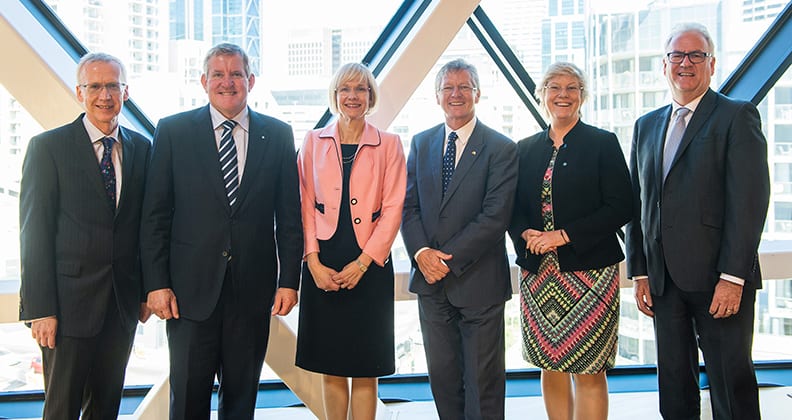The Hon Ian Macfarlane MP, Federal Minister for Industry, today launched the National Resource Sciences Precinct (NRSP), a CSIRO, Curtin University and The University of Western Australia (UWA) collaboration aiming to advance global competitiveness for the Australian resources sector.
The NRSP is like a portal through which companies and government can readily connect with world-leading expertise and gain access to infrastructure to address their needs. It also aims to replace competition with collaboration between the partner organisations.
The inaugural Chair of the NRSP and the current Managing Director and Chief Executive Officer of Transfield Services, Mr Graeme Hunt, was introduced at the launch, boasting a strong minerals and energy background of almost 40 years.
“As the industry faces rising exploration costs and diminishing success rates, our dependence on innovative research and development has never been stronger,” Mr Hunt said.
“Instead of competing with one another for the same government or industry funding for research, the new alliance will work together to find opportunities for large-scale infrastructure projects developed in Perth and around Australia.
“I’m looking forward to working with CSIRO, Curtin and UWA, as not only do they have a strong history of working together, but collectively they host more than 400 FTE staff involved in resource sciences.
“With that extent of expertise pooled together, the opportunities for innovation are endless.”
Under the NRSP banner, the founding partners have already attracted nearly $17 million from the Science and Industry Endowment Fund (SIEF) for state-of-the-art minerals characterisation and Distal Footprint capability.
Recently, the NRSP’s Distal Footprints project was awarded a further $2.6 million in State Government funding to identify new methods of accurately predicting underground rock properties to help with mineral exploration.
By bringing together the best scientists within the partner organisations, the Distal Footprints project will deliver new data, interpretations, understanding and technologies to help discover mineral wealth in areas that have previously been difficult.
The Advanced Resources Characterisation Facility (ARCF) is also housed under the NRSP and includes three pieces of equipment, including the NanoSIMS probe, MAIA Mapper and Atom Probe, dedicated to helping researchers understand the properties of mineral and energy samples.
Mr Hunt said in his position as Chair, he would help the NRSP foster collaborations within the resources industry, attract the best scientists, mount infrastructure projects and link industry to research in an effective manner.
“Ultimately, it’s about getting the knowledge needed for tomorrow’s Australian resource industry, to help ensure its future success,” Mr Hunt said.
The NRSP website is at www.nrsp.com.au.
About the NRSP
The NRSP is a collaboration of three Foundation Research Partners: CSIRO, Curtin University and
The University of Western Australia; connected to a network of research, industry and government bodies acting as a catalyst for capability and infrastructure development in resource sciences.
The NRSP has been formed to:
• attract the best scientists to lead research on global resource industry challenges
• deliver strategic leadership of the resource sciences agenda through collaboration with industry, government and research institutions
• capitalise on the concentration of multinational companies and world-standard resources research capability already in Western Australia
• mount research infrastructure projects of scale and quality
• provide access for industry to world-standard research scientists and infrastructure.
The NRSP is not a management or funding body.
The NRSP is engaged with national and local innovation systems.
The NRSP has already:
• attracted almost $17 million from the Science Industry and Endowment Fund (SIEF) in research funding for state-of-the-art minerals characterisation and distal footprint capability
• leveraged grant funding to commence resource sciences research projects totalling more than $50 million
• facilitated the joint appointment of internationally-recognised scientists in computational geoscience and minerals characterisation to the Foundation Research Partners
• created the Advanced Resource Characterisation Facility to improve access and collaboration on minerals characterisation
• embarked on the cooperative development of the resources under the control of the Foundation Research Partners, including 400 FTE resource sciences research staff and 35 institutes and centres
• identified opportunities for additional funding for resource sciences research.
The NRSP will:
• formalise partnerships with industry and government to expand the resource sciences network and develop an agenda for the future
• attract additional investment in resource sciences research to enhance capability and capacity
• facilitate the appointment of further world-class resource sciences researchers
• improve industry access to the complex research capability landscape
• support Australia’s leadership in resource sciences research and industry
• improve the efficiency and effectiveness of existing resource sciences research infrastructure.
Graeme Hunt Biography
Graeme Hunt was appointed a Director of Transfield Services on 7 May 2012, and became Managing Director and Chief Executive Officer on 1 November 2012. He is currently a Director of AGL Energy Ltd.
He has almost 40 years’ experience in the metals, mining and bulk transport sectors, including years with BHP Billiton where he held positions including President Iron Ore, President Aluminium and President Uranium. He was also Managing Director and Chief Executive Officer of Lihir Gold Ltd.
Graeme has been President of the Australian Uranium Association, the Australian Mining and Metals Association and the International Manganese Institute. He has served as Deputy Chair of the Minerals Council of Australia and as a Director of the International Aluminium Institute and the World Energy Council Australia.



